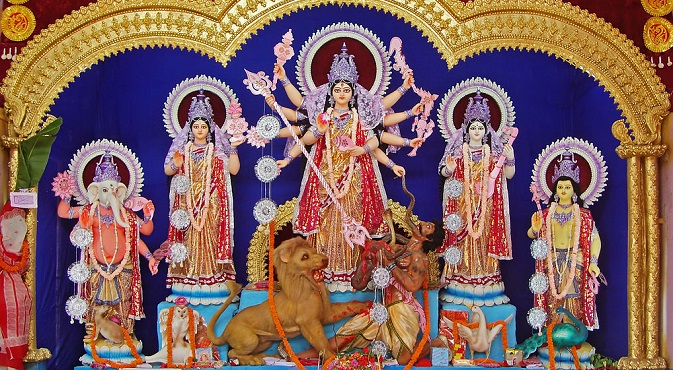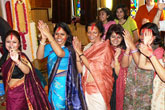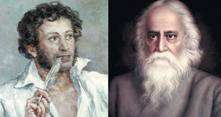Bengalis mark silver jubilee Durga Puja celebrations in Moscow

Durga sculpture from a pandal at West Bengal. Source: Joydeep / wikipedia.org
Despite many difficulties due to legal restrictions on publicly holding religious festivities in the Russian capital under the ex-Soviet Union, a handful of Bengalis came together to make the puja dream a reality in Russia. The first Durga Puja was organized in 1989, in a local House of Culture as an Indian cultural event, for which two priests were specially flown in from Kolkata. After changing several venues of puja, for about a decade, it started to be held in the Inter-Club of the Peoples’ Friendship University.
“The main purpose of starting Durga Puja in Moscow was to bring a flavour of Bengali Durga Puja at a home away from home,” said Nitin Aurangabadkar, General Secretary of Moscow Puja Committe.
The first Durga Puja was inaugurated by Swami Lokeswarananda (Ramakrishna Mission). Since then Swami Jyotirupananda, the president of the Moscow Durga Puja Committee and the founder of Moscow Ramakrishna Mission, has annually conducted the Puja.
The puja is organized by the Moscow Durga Puja Committee. It’s funded by voluntary contributions from Bengalis and the other members of the Indian community, living in the Russian capital. The Indian Embassy in Moscow assists the Committee in bringing the Durga idol and the other special things used for puja from Kolkata.
Purchased from Kumhartoli in Kolkota, the Durga idol is usually changed every three years. To mark the Silver Jubilee this year, the Puja Committee has brought a new Durga idol, which is the biggest, so far, compared to previous idols, in Moscow.
“In the last 25 years, the Durga Puja has become increasingly popular year by year,” Aurangabadkar, who is married to a Bengali, said. “At present, more and more members of Indian community, people from other states in India, join the puja celebrations and different festivities devoted to Navratra,” he added.
“Today the Durga Puja in Moscow, has grown into a social-religious-cultural event, bringing together different people from India which also renews fellow-feeling among members of Indian community,” Auranagabadkar noted. “For Bengalis, the Durga Puja changed the ethos of their life-style, in Moscow.”
According to Puja Committee, in Moscow there are about 20 Bengali families, but during the puja days up to 1,000 people participate in the festivities, including Indians and Russians. Many Russian Indologists, Professors and students of the Moscow State Institute of International Relations (MGIMO) who study Bengali also take part in the Durga Puja celebrations.
In Moscow, the Puja is performed on the very “actual dates” of the Navratra. During puja days, a number of cultural functions are organized, which include presentation of songs, dances, holding of contests and quizzes and reciting poems, in particular, Rabindra Sangit.
“Traditional Aarti, Puja, Bhog, Sandhi Puja with the 108 lamps, Sindur Khela and symbolic immersion is carried out every year,” Rathin Chatterjee said. Chatterjee, who is a senior member of the Puja Committee, performs the Puja rituals at the special pandal, under the guidance of Maharaj from Ramakrishna Mission, Moscow.
“Our puja conveys a strong message of harmony and goodwill among diverse peoples, participating in the puja,” he said.
To mark the Silver Jubilee, the Ananda Mela which is celebrated every year, has been organized as a special event. Generally, the Ananda Mela is organized as a food festival- cum-competition under Puja Committee. Indian women prepare different food delicacies at home for competition.
Ananda Mela is held on Navami, but this year it was organized two weeks in advance, as Navami and Dashami overlap on the same day, leaving little room for other non- ritual events.
Another special event to mark the Silver Jubilee is a concert to be held on October 11. Aneek Dhar, a young talented singer from Kolkata will be the star attraction of the concert. Exhibitions on Bengali culture, paintings and sculpture by Russian artists on Indian and Bengali themes are also being organized.
This year a charity show by the disabled students of a Moscow school for orphans is being organized. The organizers of the charity show said the money collected will be donated for the benefit of the disabled students.
Since the number of Bengalis living in Moscow is very less, no newspapers or magazines are published on a regular basis. There is only one annual puja magazine called Aaratrika which is published annually and released on the occasion of Saptami evening (7th day of Navratra) at a cultural function.
“Many Bengalis here are mixed families. They have married Russians,” said Mrs Krishna Roy. “However, it does not prevent them from coming together to enjoy Durga Puja,” she said.
“Special Bengali food stalls, ethnic clothes, cultural programmes, the performance of traditional rites and rituals create the perfect ambience for the celebrations of Durga Puja in Moscow,” she said, adding “The most interesting thing about Durga Puja is the ‘Bhog’ that is served on “Maha-Navami”- the 9th day of Navratra.”
On Vijay-Dashami, (Dussehra) the last day of the festivities, the Durga idol is symbolically immersed in the river. Sindur Khela (vermilion game) is the culmination of the festival during which married women apply vermilion to each other.
Durga Puja in Moscow, is not the only social-religious-cultural event to which Bengalis’ participation is limited. They also celebrate their traditional, colourful Bengali New Year (Pohela Boishakh) on the first day of Boishakh (the first month of Bengali calendar). “But Bengali New Year is absolutely a family festival, celebrated on personal level. It’s another occasion for Bengali families to gather, mix and enjoy life,” Auranagbadkar said.
All rights reserved by Rossiyskaya Gazeta.
Subscribe
to our newsletter!
Get the week's best stories straight to your inbox


